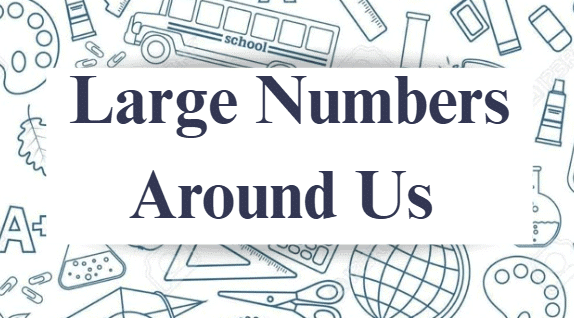Class 7 Maths Chapter 1 Question Answers - Large Numbers Around Us

Q1: Write in numerals: twelve crore thirty-four lakh fifty-six thousand seven hundred eighty-nine.
Ans: 12,34,56,789
Explanation: In the Indian system we group digits as crore, lakh, thousand, and hundreds.
Here, “twelve crore” gives 12 in the crore place, “
thirty-four lakh” gives 34 in the lakh place,
“fifty-six thousand” gives 56 in the thousand place, and “seven hundred eighty-nine” fills the last three digits .
Q2: Convert the number 9,45,32,106 into words in the Indian system.
Ans: Nine crore forty-five lakh thirty-two thousand one hundred six
Q3: Using the digits 0, 1, 3, 5, 6, 8, 9, form the greatest and the smallest seven-digit numbers.
Ans: Greatest number:
To form the greatest number, we arrange the digits in descending order:
9, 8, 6, 5, 3, 1, 0
So, the greatest seven-digit number is:
9,865,310Smallest number:
To form the smallest number, we arrange the digits in ascending order, but a number cannot start with 0. So, we start with the smallest non-zero digit, which is 1, and then arrange the remaining digits in ascending order:
1, 0, 3, 5, 6, 8, 9
So, the smallest seven-digit number is:
10,35,689
Q4: Express 7,56,83,291 in the international system and write it in words.
Ans: 75,683,291; seventy-five million six hundred eighty-three thousand two hundred ninety-one
Explanation: In the international system we group digits by threes from the right: 75 | 683 | 291.
Reading: 75 million 683 thousand 291; in words: seventy-five million six hundred eighty-three thousand two hundred ninety-one.
Q5: Identify the digit in the ten-thousands place of 4,28,75,160 and state its place value.
Ans: Digit = 7; place value = 7 × 10,000 = 70,000
Explanation: In 4,28,75,160 the digits from right are units (0), tens (6), hundreds (1), thousands (5), ten-thousands (7).
Thus the ten-thousands digit is 7, whose value is 70,000. .
Q6: Compare using “>” or “<”: 2,34,56,789 ___ 2,43,56,789.
Ans: 2,34,56,789 < 2,43,56,789
Explanation: Compare place by place from the left:
Both have 2 crore, but in the lakh place 34 < 43,
so 2,34,56,789 is less than 2,43,56,789. .
Q7: Arrange in descending order:
• 12,34,56,789
• 12,345,678
• 1,23,45,678
• 1,234,567
Ans: To arrange the numbers in descending order, we compare them based on the number of digits and place value.
Let’s write the numbers in standard international format for better comparison:
12,34,56,789 = 123,456,789
12,345,678 = 12,345,678
1,23,45,678 = 12,345,678
1,234,567 = 1,234,567
Now, arrange them from greatest to smallest:
123,456,789 > 12,345,678 = 12,345,678 > 1,234,567
So, in the original Indian number format:
Final Answer (Descending Order):
12,34,56,789 > 12,345,678 = 1,23,45,678 > 1,234,567
Q8: Which is greater, 0.345 million or 34.5 lakh, and by how much?
Ans: 34.5 lakh is greater by 3,105,000
Explanation: 0.345 million = 345,000.
34.5 lakh = 3,450,000.
Subtracting: 3,450,000 − 345,000 = 3,105,000.
So 34.5 lakh exceeds 0.345 million by 3,105,000.
Q9: True or False: 1 billion is equal to 100 crore in the Indian system.
Ans: True; 1 billion = 1,000 million = 100 crore
Explanation: Since 1 million = 10 lakh, 1 billion = 1,000 million = 10,000 lakh = 100 crore.
Q10: Round off 6,24,894 to the nearest thousand.
Ans: 6,25,000
Explanation: Check the hundreds digit (8) in 894 is greater than 5, so thousands place (24 thousand) rounds up to 25 thousand.
Other digits become zeros: 6,25,000. .
Q11: Round off 8,23,49,161 to the nearest ten lakh.
Ans: Step 1: Identify the ten lakh place.
In 8,23,49,161, the ten lakh digit is 2 (in 23 lakh).Step 2: Look at the digit in the lakh place, which is 3.
Since 3 < 5, we do not increase the ten lakh digit.
Replace all digits after the ten lakh place with zeros.
So, 8,23,49,161 rounded to the nearest ten lakh is:
8,20,00,000
Q12: Round off 7,68,429 to the nearest ten thousand.
Ans: 7,70,000
Explanation: Check the thousands digit (8) in 8,429 is greater than 5,
so ten-thousands place (6 ten-thousands) rounds up to 7 ten-thousands.
Result: 7,70,000.
Q13: How many lakhs make a billion?
Ans: 10,000
Explanation:We know that:
1 billion = 1,000,000,000
1 lakh = 1,00,000
Now, to find how many lakhs make 1 billion, we divide:
1,000,000,000 ÷ 1,00,000 = 10,000
Q14: A delivery van travels 56,789 km in Year 1 and 67,890 km in Year 2. What is the total distance covered in two years?
Ans: 1,24,679 Km
Explanation: 56,789 + 67,890 = 1,24,679 km
Q15: A museum receives a donation of ₹ 3.27 crore. Express this amount in rupees and in the international system (with words).
Ans: ₹ 32,700,000; thirty-two million seven hundred thousand
Explanation: Since 1 crore = 10,000,000,
3.27 crore = 3.27 × 10,000,000 = 32,700,000 rupees.
In international grouping that is 32 | 700 | 000 → 32 million 700 thousand, read as thirty-two million seven hundred thousand.
|
41 videos|251 docs|8 tests
|
FAQs on Class 7 Maths Chapter 1 Question Answers - Large Numbers Around Us
| 1. What are large numbers and why are they important in our daily lives? |  |
| 2. How do we express large numbers in a more manageable way? |  |
| 3. What role do large numbers play in scientific research? |  |
| 4. Can you give examples of large numbers used in everyday contexts? |  |
| 5. How can understanding large numbers benefit students in their studies? |  |

















